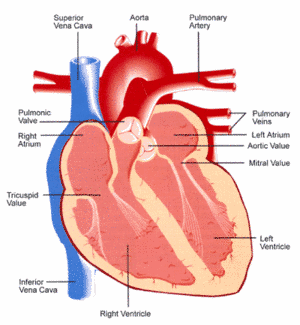Dog Heartworm Symptoms

Heartworms have been recorded in dogs in every US state. As the name suggests, it is a disease in which parasitic worms inhabit the heart and surrounding blood vessels of affected dogs.
These worms resemble spaghetti in size and shape and can grow up to 14 inches (35cm) long. Females are larger than males. Infected dogs can have anything up to 250 worms in their heart, but most have between 15 and 20 of the parasites.
As you could imagine, strands of spaghetti greatly affect the heart's ability to pump out blood. Most heartworm effects are attributable to this condition. The more worms, the more severe the effects.
From the time of infection, it takes about four months for immature worms to reach the heart and another two months for them to mature into adults. Before this time, the dog will display no heartworm disease symptoms. Inactive dogs or those which have low worm burdens may never develop any symptoms at all. A dog's immune reaction and the amount of time since infection began will also have a bearing on any symptoms.

- blood returns from the body through the vena cava (a vein) into the right atrium or top chamber.
- blood is pumped into the right ventricle (or bottom chamber), then through the pulmonary artery to the lungs.
- in the lungs, the blood is oxygenated and pumped back to the heart through the pulmonary vein, ready to supply the rest of the body.
- the blood is then pumped through the left atrium into the muscular left ventricle and out to the body through an artery called the aorta.
Heartworms live primarily in the pulmonary artery, which carries blood from the heart to the lungs. Larger worm infestations will mean they spill over into the right ventricle; if larger still they may extend back into the right atrium or even into the vena cava.
Thus heartworms obstruct blood flow from the heart into the lungs, and can irritate the lungs by their presence in the arteries. The right ventricle of the heart pumps harder to try to push more blood through to the lungs. This raises the blood pressure in the lungs and causes some of the plasma (fluid part) of blood to leak out into the lung tissue, causing fluid on the lungs. This causes a soft cough and initially reduces exercise tolerance. The dog may also become more lethargic.
|
"[Heartworm] disease is treatable, however
treatment can be associated with complications , and if not treated, it can be fatal. Prevention is definitely better than cure."
|
The heart muscle wall works very hard to overcome the restriction caused by the heartworms, and the muscle often thickens to gain strength. However this does not have the positive effect desired, as the wall becomes stiffer and the chamber's volume actually decreases due to the thicker wall. This means less blood is moved per heartbeat.
Eventually, blood has difficulty entering the heart and starts to back up in the vena cava. The signs of disease worsen: the dog develops a chronic cough, may have difficulty breathing and may collapse after exercise. Dogs with heartworm disease can have a reduced appetite and suffer weight loss. Often the blood plasma accumulates in the abdomen, giving the dog a pot-bellied look which can obscure the signs of weight loss. These are signs of heart failure.
|
Anti-heartworm treatments
|
| Pet Shed's most popular solutions for ridding your pet of heartworm: |
In extremely severe cases, a condition known as "caval syndrome" can occur. The worms block the valve between the right atrium and ventricle so the blood cannot be pumped properly. The vena cava fills with blood which cannot return to the heart, in particular the arm of the vein returning blood from the liver. This means the pressure builds up in the liver with congested blood trying to return to the heart.
This damages the liver and the dog suddenly becomes weak, anorexic, displays rapid breathing then collapses; the dog has gone into shock. These dogs have dark brown urine, due to the breakdown products of blood. This is an emergency situation: if the worms are not removed immediately, these animals can die within 48 hours.
|
"This is an emergency situation: if the worms are not removed immediately, these animals can die within 48
hours."
|
Some blood cells can stick to the worms as they flow past, forming a clot which can dislodge and get stuck in the lungs, blocking further blood flow. If this occurs symptoms can include coughing up blood. Occasionally the blood clot, known as an embolus, travels to other organs such as the kidneys, the brain or the heart itself, blocking the blood flow. This can cause organ failure due to lack of blood and can also result in death.
The symptoms of heartworm are not pleasant. The disease is treatable, however treatment can be associated with complications , and if not treated, it can be fatal. Prevention is definitely better than cure. Ensure your dog is on preventative medication throughout the entire heartworm transmission season to prevent infection. There are many effective, easy-to-administer medications available. Your veterinarian can advise the appropriate treatment length for your area and prescribe appropriate preventative medication for your dog.
|
References
|
| American Heartworm Society. http://www.heartwormsociety.org/heart.htm Payne, P.A., Dryden, M.W., Carter, G.R. External Parasitic Diseases of Dogs and Cats. In: A Concise Guide to Infectious and Parasitic Diseases of Dogs and Cats International Veterinary Information Service, Ithaca NY. www.ivis.org McCall J.W. et al. Recent advances in heartworm disease. Veterinary Parasitology 125:105-130, 2004. Heartworm. Michigan Department of Agriculture. www.michigan.gov/mda Tilley, L.P., Smith, F.W.K. The Five Minute Veterinary Consult Canine and Feline. Second Edition. Lippincott Williams & Wilkins, Baltimore, 2000. |